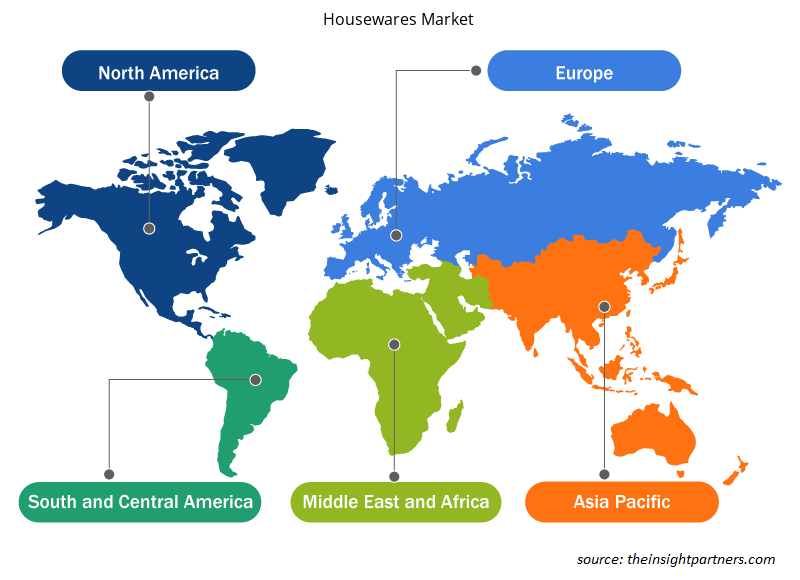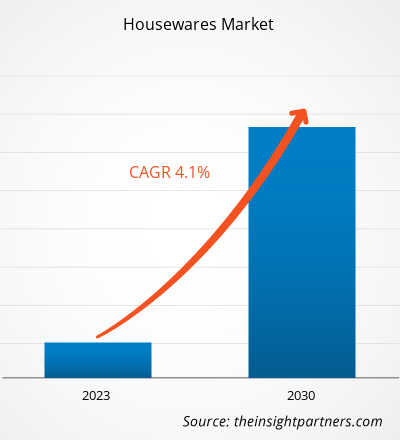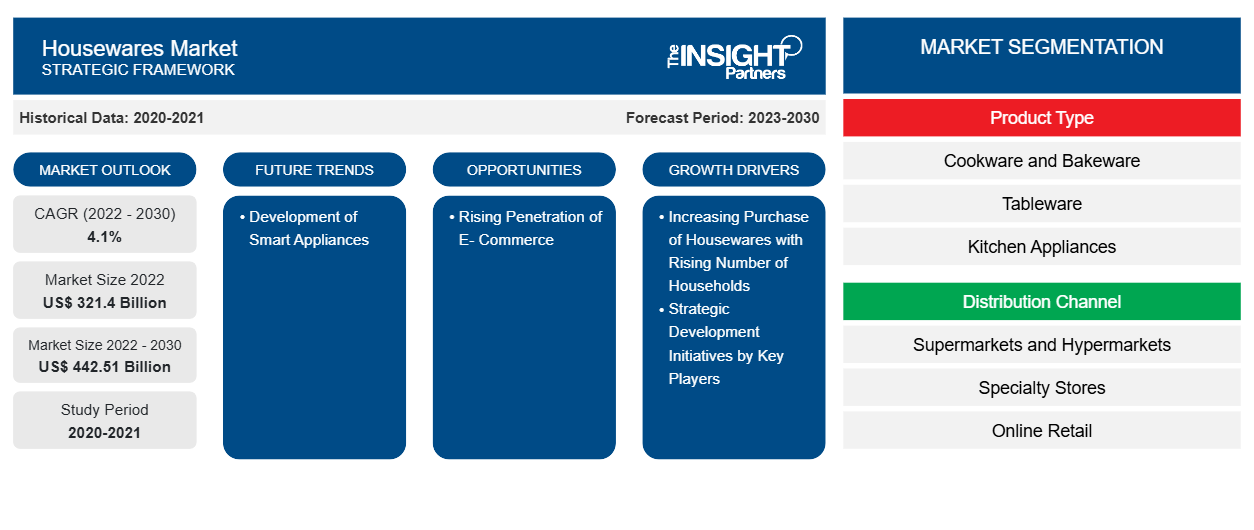[Forschungsbericht] Der Markt für Haushaltswaren wurde im Jahr 2022 auf 321,40 Milliarden US-Dollar geschätzt und soll bis 2030 442,51 Milliarden US-Dollar erreichen; von 2022 bis 2030 wird eine durchschnittliche jährliche Wachstumsrate (CAGR) von 4,1 % erwartet.
Markteinblicke und Analystenansichten:
Haushaltswaren sind Produkte und Gegenstände, die im Haushalt unter anderem zum Kochen, Backen und zur Organisation des Haushalts verwendet werden. Der Haushaltswarenmarkt wächst stetig aufgrund von Faktoren wie veränderten Lebensstilen und mehr Zeit, die zu Hause verbracht wird, was die Nachfrage nach funktionalen und ästhetisch ansprechenden Haushaltswaren ausgelöst hat. Während der COVID-19-Pandemie verbrachten die Menschen mehr Zeit zu Hause und investierten in die Verbesserung ihrer Wohnräume. Darüber hinaus hat ein Anstieg des E-Commerce und von Online-Shopping-Plattformen es den Verbrauchern erleichtert, von zu Hause aus auf eine breite Palette von Haushaltswaren zuzugreifen und diese zu kaufen. Diese Faktoren, gepaart mit innovativen Designs und nachhaltigen Optionen, die von Haushaltswarenunternehmen angeboten werden, begünstigen die Expansion des Haushaltswarenmarktes.
Wachstumstreiber und Herausforderungen:
Dynamische Veränderungen im Lebensstil und die steigende Zahl von Doppelverdienerfamilien führten zu einem Anstieg des verfügbaren Einkommens und einem verbesserten Lebensstandard der Haushalte. Mit steigendem verfügbaren Einkommen geben Verbraucher erhebliche Summen für Haushaltswaren und andere Geräte aus, die das Leben erleichtern. Sie sind oft bereit, neue Produkte zu kaufen, da sie einen einzigartigen Stil haben, der ihre Individualität anspricht, was zu einer höheren Kauffrequenz führt. Darüber hinaus macht eine wachsende Zahl von Einpersonenhaushalten Umbauten im Haus erforderlich, was die Nachfrage nach Haushaltswaren wie Küchengeräten, Kochgeschirr, Backgeschirr, Tafelgeschirr und Badezimmerutensilien ankurbelt.
Darüber hinaus hat die zunehmende Urbanisierung die Nachfrage nach Wohneinheiten und letztlich nach Haushaltswaren angekurbelt. Laut dem US Census Bureau und dem US Department of Housing and Urban Development wurden in den USA im Jahr 2021 etwa 1,3 Millionen Wohneinheiten fertiggestellt, während der Bau von etwa 1,7 Millionen Wohneinheiten im Gange war. Ebenso hat die zunehmende Urbanisierung in europäischen Ländern eine enorme Nachfrage nach Wohnraum geschaffen. Laut der Europäischen Kommission stiegen die Baugenehmigungen für Wohnimmobilien in der Europäischen Union von 2015 bis 2021 um 42,3 %. Im Jahr 2021 verzeichneten Frankreich, Deutschland und Polen die meisten Wohnungsbaubeginne in Europa. Der zunehmende Bau von Wohneinheiten in verschiedenen Ländern steigert also die Nachfrage nach Haushaltswaren weiter. Der zunehmende Kauf von Haushaltswaren zusammen mit der steigenden Zahl von Haushalten treibt also das Wachstum des Haushaltswarenmarktes voran.
Der Haushaltswarenmarkt ist jedoch stark fragmentiert und unorganisiert, da in Entwicklungsländern viele unerschlossene kleine Privatunternehmen und Straßenhändler tätig sind. Laut einem in Business Standards veröffentlichten Artikel waren im Jahr 2020 80 % des Küchenwarenmarkts in Indien unorganisiert. Lokale Kleinunternehmen verwenden minderwertige Rohstoffe zur Herstellung von Haushaltswaren wie Kochgeschirr, Backgeschirr, Badezimmerzubehör und Tischgeschirr. Die Verwendung minderwertiger Rohstoffe führt zu minderwertigen Endprodukten, die anfällig für Beschädigungen sind. Außerdem bieten die Hersteller diese Produkte zu niedrigen Preisen an; daher kauft die Mehrheit der Verbraucher diese Produkte aufgrund der Erschwinglichkeit und leichten Verfügbarkeit. Dieser Faktor führt dazu, dass der Kundenstamm der großen Haushaltswarenhersteller schrumpft.
Darüber hinaus erfüllen lokale Hersteller auf dem unorganisierten Haushaltswarenmarkt häufig nicht die gesetzlichen Vorschriften, was zu Qualitätsproblemen führen und die Wahrnehmung von Haushaltswaren durch die Verbraucher beeinträchtigen kann. Darüber hinaus kann die Verfügbarkeit gefälschter Produkte das Markenimage wichtiger Akteure beeinträchtigen. Somit behindert der Mangel an Einheitlichkeit bei Abläufen und Vorschriften das Wachstum des Haushaltswarenmarktes.
Passen Sie diesen Bericht Ihren Anforderungen an
Sie erhalten kostenlose Anpassungen an jedem Bericht, einschließlich Teilen dieses Berichts oder einer Analyse auf Länderebene, eines Excel-Datenpakets sowie tolle Angebote und Rabatte für Start-ups und Universitäten.
-
Holen Sie sich die wichtigsten Markttrends aus diesem Bericht.Dieses KOSTENLOSE Beispiel umfasst eine Datenanalyse von Markttrends bis hin zu Schätzungen und Prognosen.
Berichtssegmentierung und -umfang:
Der globale Haushaltswarenmarkt ist nach Produkttyp, Vertriebskanal und Geografie segmentiert. Basierend auf dem Produkttyp wird der Markt in Koch- und Backgeschirr, Tafelgeschirr, Küchengeräte, Badezimmerbedarf und Sonstiges unterteilt. Nach Vertriebskanal wird der Markt in Supermärkte und Hypermärkte, Fachgeschäfte, Online-Einzelhandel und Sonstiges unterteilt. Nach Geografie ist der globale Haushaltswarenmarkt grob in Nordamerika, Europa, Asien-Pazifik, den Nahen Osten und Afrika sowie Süd- und Mittelamerika segmentiert.
Segmentanalyse:
Basierend auf dem Produkttyp wird der Haushaltswarenmarkt in Koch- und Backgeschirr, Tafelgeschirr, Küchengeräte, Badezimmerutensilien und Sonstiges unterteilt. Das Tafelgeschirrsegment wird voraussichtlich zwischen 2022 und 2030 die höchste durchschnittliche jährliche Wachstumsrate verzeichnen. Das Tafelgeschirrsegment umfasst Produkte wie Geschirr, Besteck, Glaswaren und Serviergeschirr. Ein Anstieg der Nachfrage nach Tafelgeschirr auf dem Haushaltswarenmarkt kann auf veränderte Essgewohnheiten während der COVID-19-Pandemie zurückgeführt werden. Da immer mehr Menschen zu Hause essen, haben sie begonnen, sich auf ästhetisches und funktionales Tafelgeschirr zu konzentrieren, da es das Esserlebnis zu Hause verbessert. Von alltäglichen Mahlzeiten bis hin zu besonderen Zusammenkünften suchen Verbraucher nach Tafelgeschirrsets, die ihr Esserlebnis verbessern. Darüber hinaus spielt die wachsende Wertschätzung für einzigartige und handwerkliche Designs eine bedeutende Rolle bei der Nachfrage nach Tafelgeschirr. Verbraucher fühlen sich zunehmend von handgefertigtem und künstlerisch inspiriertem Tafelgeschirr angezogen, das ihrem Essbereich einen Hauch von Individualität und Persönlichkeit verleiht. Daher hat eine Verlagerung hin zu personalisierteren und optisch ansprechenderen Tafelgeschirroptionen zum Fortschritt des Haushaltswarenmarkts für das Tafelgeschirrsegment beigetragen. Vivo – Villeroy & Boch Group, Corelle, Pyrex, Luminarc und Schott Zwiesel sind einige der führenden Akteure auf dem Markt für Tischgeschirr.
Regionale Analyse:
Der Haushaltswarenmarkt ist in fünf Schlüsselregionen unterteilt: Nordamerika, Europa, Asien-Pazifik, Süd- und Mittelamerika sowie Naher Osten und Afrika. Der Asien-Pazifik-Raum dominierte 2022 den globalen Haushaltswarenmarkt, da der Markt in dieser Region in diesem Jahr auf 120,63 Milliarden US-Dollar geschätzt wurde. Europa ist ein zweiter wichtiger Beitragszahler und hält einen Anteil von mehr als 23 % am Weltmarkt. Der Asien-Pazifik-Raum wird im Zeitraum 2022–2030 voraussichtlich eine beträchtliche durchschnittliche jährliche Wachstumsrate von über 5 % verzeichnen. Die zunehmende Urbanisierung und das verfügbare Einkommen der Mittelschicht sind ein Hauptfaktor, der die Nachfrage nach modernen und praktischen Haushaltswaren, einschließlich fortschrittlicher Küchengeräte und stilvollem Geschirr, antreibt.
Regionale Einblicke in den Haushaltswarenmarkt
Die regionalen Trends und Faktoren, die den Haushaltswarenmarkt im Prognosezeitraum beeinflussen, wurden von den Analysten von Insight Partners ausführlich erläutert. In diesem Abschnitt werden auch die Marktsegmente und die Geografie des Haushaltswarenmarkts in Nordamerika, Europa, im asiatisch-pazifischen Raum, im Nahen Osten und Afrika sowie in Süd- und Mittelamerika erörtert.

- Holen Sie sich die regionalspezifischen Daten für den Haushaltswarenmarkt
Umfang des Haushaltswarenmarktberichts
| Berichtsattribut | Details |
|---|---|
| Marktgröße im Jahr 2022 | 321,4 Milliarden US-Dollar |
| Marktgröße bis 2030 | 442,51 Milliarden US-Dollar |
| Globale CAGR (2022 - 2030) | 4,1 % |
| Historische Daten | 2020-2021 |
| Prognosezeitraum | 2023–2030 |
| Abgedeckte Segmente |
Nach Produkttyp
|
| Abgedeckte Regionen und Länder |
Nordamerika
|
| Marktführer und wichtige Unternehmensprofile |
|
Marktteilnehmerdichte: Der Einfluss auf die Geschäftsdynamik
Der Haushaltswarenmarkt wächst rasant, angetrieben durch die steigende Endverbrauchernachfrage aufgrund von Faktoren wie sich entwickelnden Verbraucherpräferenzen, technologischen Fortschritten und einem größeren Bewusstsein für die Vorteile des Produkts. Mit steigender Nachfrage erweitern Unternehmen ihr Angebot, entwickeln Innovationen, um die Bedürfnisse der Verbraucher zu erfüllen, und nutzen neue Trends, was das Marktwachstum weiter ankurbelt.
Die Marktteilnehmerdichte bezieht sich auf die Verteilung der Firmen oder Unternehmen, die in einem bestimmten Markt oder einer bestimmten Branche tätig sind. Sie gibt an, wie viele Wettbewerber (Marktteilnehmer) in einem bestimmten Marktraum im Verhältnis zu seiner Größe oder seinem gesamten Marktwert präsent sind.
Die wichtigsten auf dem Haushaltswarenmarkt tätigen Unternehmen sind:
- Bradshaw Home Inc
- Die Denby Pottery Co Ltd
- HF Coors Co Inc
- Inter Ikea Holding Bv
- Hutzler Manufacturing Co Inc
Haftungsausschluss : Die oben aufgeführten Unternehmen sind nicht in einer bestimmten Reihenfolge aufgeführt.

- Überblick über die wichtigsten Akteure auf dem Haushaltswarenmarkt
Auswirkungen der COVID-19-Pandemie:
Die COVID-19-Pandemie behinderte den globalen Haushaltswarenmarkt zunächst aufgrund der Schließung von Produktionsstätten, Arbeitskräftemangel, Unterbrechung der Lieferketten und finanzieller Instabilität. Die Betriebsunterbrechung in verschiedenen Branchen aufgrund der durch den COVID-19-Ausbruch verursachten Konjunkturabschwächung schränkte das Haushaltswarenangebot ein. Darüber hinaus wurden verschiedene Geschäfte geschlossen, was den Verkauf von Haushaltswaren einschränkte. Dennoch begannen die Unternehmen, an Boden zu gewinnen, als zuvor verhängte Beschränkungen in verschiedenen Ländern im Jahr 2021 aufgehoben wurden. Darüber hinaus entspannte die Umsetzung von COVID-19-Impfkampagnen durch Regierungen verschiedener Länder die Situation und führte zu einem Anstieg der Geschäftsaktivitäten weltweit. Mehrere Märkte, darunter der Haushaltswarenmarkt, verzeichneten nach der Lockerung der Ausgangssperren und Bewegungseinschränkungen ein Wachstum.
Wettbewerbslandschaft und Schlüsselunternehmen:
Zu den führenden Akteuren auf dem globalen Haushaltswarenmarkt zählen Bradshaw Home Inc, Denby Pottery, HF Coors Co Inc, Inter Ikea Holding Bv, Hutzler Manufacturing Co Inc, TTK Prestige Ltd, Newell Brands Inc, BSH Hausgeräte GmbH, Kohler Co und Haier US Appliance Solutions Inc.
- Historische Analyse (2 Jahre), Basisjahr, Prognose (7 Jahre) mit CAGR
- PEST- und SWOT-Analyse
- Marktgröße Wert/Volumen – Global, Regional, Land
- Branchen- und Wettbewerbslandschaft
- Excel-Datensatz
Aktuelle Berichte
Erfahrungsberichte
Grund zum Kauf
- Fundierte Entscheidungsfindung
- Marktdynamik verstehen
- Wettbewerbsanalyse
- Kundeneinblicke
- Marktprognosen
- Risikominimierung
- Strategische Planung
- Investitionsbegründung
- Identifizierung neuer Märkte
- Verbesserung von Marketingstrategien
- Steigerung der Betriebseffizienz
- Anpassung an regulatorische Trends























 Kostenlose Probe anfordern für - Haushaltswarenmarkt
Kostenlose Probe anfordern für - Haushaltswarenmarkt